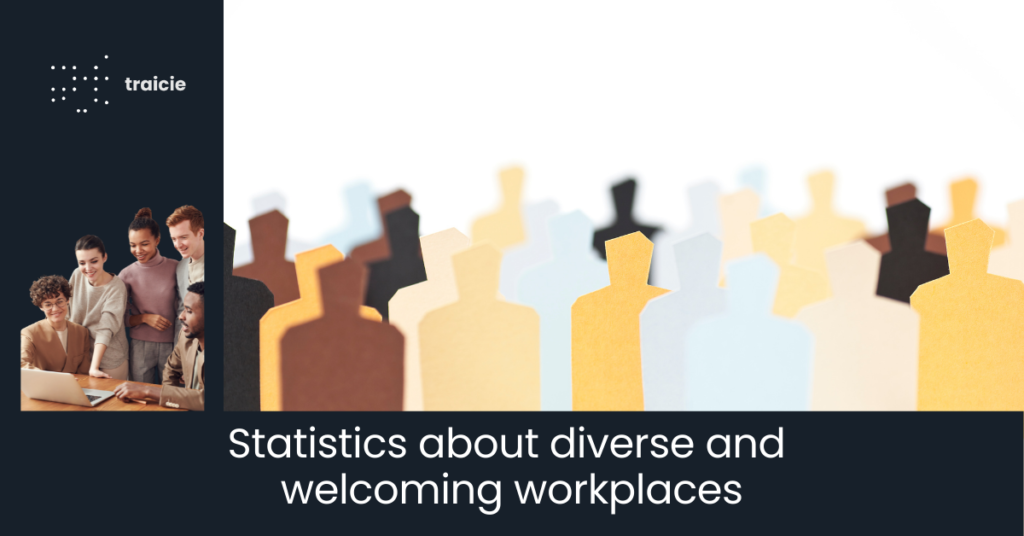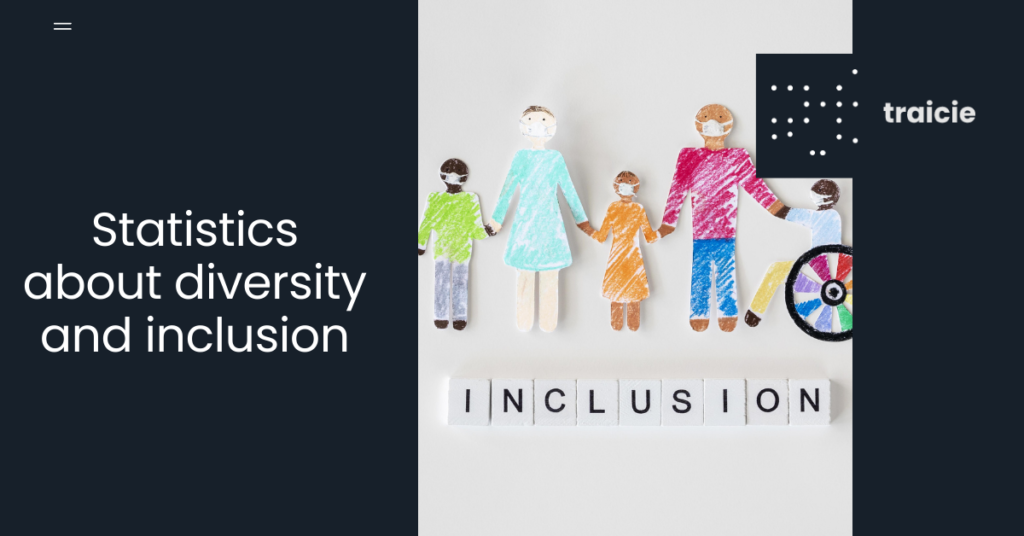In the business world, DEI, which stands for diversity, equity, and inclusion, has been a hot topic for the past few years. You’ve probably heard these topics in meetings, looked for a company that puts diversity, equity &inclusion statistics at the centre of its culture, or started a business yourself.
| >>> You might interested in Free Personality Survey for Career to pinpoint what makes you unique.
If you don’t know much about these subjects, you might wonder what diversity, equity, and inclusion statistics mean in a business setting and why they’re so important. Son let’s dive in!
Statistics about diverse and welcoming workplaces

The demographics of the working force within the U.S. has drastically changed in the last four decades. In the 40 years between 1980 and 2020, the number of white workers has dropped from 83% of the total population to 63%, while the number of workers from other groups has doubled.
Two things are causing this change. First, baby boomers reach retirement age and leave the workforce. Second, the number of people coming from a minority group has grown in the younger generations. These “younger” people are looking for workplaces that reflect the country’s demographics and make them feel welcome and respected.
2. Diversity in the workplace are found to be essential by 67% of people looking for a job
More than 50% of people who already have a job want their workplace to do more to increase diversity. (Glassdoor)
Glassdoor surveyed that a diverse workplace is one of the most important things people look for in a job. Most white workers found that diversity, equity, and inclusion statistics were necessary to have a diverse workplace. Still, it was essential to minority job seekers: 89% of African Americans, 80% of Asians, and 70% of Latinos said it was necessary for their job search.
traicie supports companies that make diversity and inclusion their primary focus. Discover how traicie strives toward an inclusive and diverse world with our recruitment algorithm, and book a demo.
A diverse and welcoming workplace is essential if you want to get good employees and help your business succeed.
3. Why do workers want more diversity, equity, and inclusion statistics at the workplace?
It’s not just because the country’s population is changing. 45% of American workers have been mistreated or harassed at work in the past year. (Gallup)
About half of the American workers (55%) agree that their workplace has DE&I policies. This means that not only a majority of the workers, but at least half of the remaining 45% of the workforce, work for companies that don’t apply their diversity, equity, and inclusion statistics system at the workplace. This hurts a company’s safety, health, and ability to keep employees, as well as its ability to make money.
4. Shareholder returns are 34% higher when more women are in C-suite-level positions. (Fast Business)
Companies with more women in leadership positions do better than those where less than half of these positions are filled by woman.
A list of Fortune 1000 companies shows how important it is for a company to have a female CEO. Women run only 5% of companies, but those companies bring in 7% of the total income of the Fortune 1000 list. The S&P 500 index also does better than these companies. In short, having women in leadership positions is good for business.
5. Innovation sales were 19% higher at companies with more diversity than average.
In 2018, the Harvard Business Review did a study that found that the most diverse companies were also the most innovative. This meant that they could offer consumers a better range of great products.
In this study, HBR looked at how diverse each company was in six ways: migration, industry, career path, gender, education, and age. They found that industry, country of origin, and gender had the most significant effects. Moreover, multidimensional companies could lead in innovation if they could find diversity in their office in more than one way.
6. A McKinsey report, written in 2015, states that companies in the top quarter for racial/ethnic diversity are 35% more likely to beat their peers, while those in the same bracket for gender diversity are 15% more likely to do the same. (McKinsey)
In its report, McKinsey looked at 366 companies in the Americas and the UK. They found a strong link between a company’s higher-than-average diversity (in terms of race/ethnicity and gender) and its higher-than-average profits compared to similar companies.
They agree that it’s hard to put diversity, equity, and inclusion statistics programs into action and make the workplace more diverse. However, they also state there are strong reasons to try.
Statistics on company performance diversity in the workplace
- Companies seen as more diverse and welcoming are 35% more likely to do better than their rivals. (McKinsey)
- Companies with many different products are 70% more likely to find new markets. (HBR)
- Teams with a variety of people are 87% better at making decisions. (People Management)
- Companies with diverse management teams make 19% more money. (BCG)
Statistics on the number of men and women in the workplace
- Only 6.6% of the Fortune 500 are women. (Fortune)
- Companies with the same number of men and women working for them make up to 41% more money. (Clear Business)
- The GDP could grow by 26% if the workforce was more diverse in the same way. (McKinsey)
- Companies that mix men and women are 15% more likely to see higher profits. (McKinsey)
- Forty percent of people think women are treated differently than men. (Clear Business)
- Only 23% of the people in the C-Suite are women. (Workplaces with Women)
- In the past year, 45 percent of American workers have been mistreated or harassed. (Gallup)
| >>> You might also wonder about: 70+ Recruiting Statistics and Effective Hiring Trends in 2022
Statistics about diversity and inclusion

- Diversity, equity and inclusion statistics are essential factors for most candidates today: 76% of people say that having a diverse workforce is an important thing to look for when judging companies and job offers. (Glassdoor)
- 57% of employers say they have changed how they hire people to make their teams more diverse (Myshortlis. ter). A Monster survey found that 30% of companies don’t have any D&I plan in place (Monster)
- Diverse teams make decisions 87% better (PPM)
- In the UK, 78% of white people had jobs, while only 66% of all other ethnic groups put together did (GOV)
- By the end of 2020, only 3.5 percent of FTSE 100 leaders would be from an ethnic minority, down from 7 percent in 2019 and 8 percent in 2018. (Green Park, 2021).
- Minority groups think less of companies that have a diversity and inclusion policy but don’t show proof of a diverse and inclusive workplace (Wilton, 2020)
- It has been shown that having leaders and managers from different backgrounds can increase a company’s income by about 19% (InStride)
- 35% of HR leaders say diversity, fairness, and inclusion are among their top five priorities for 2022 (Gartner)
- Only 47% of managers feel ready to talk to their employees about race (Gallup)
- There is still not enough social mobility. 60% of the people in professional and management positions who answered the survey are white. With only 34% coming from a low-income ethnic minority background (KPMG)
- Almost 70% of companies say that the work their employees do to promote DEI is very or vital (Mckinsey)
- 34% of employees have had training on how to deal with racism in the past year (Mckinsey)
- 70% of companies think that remote work will help them hire people from a broader range of backgrounds (Mckinsey)
- Millennials are 83% more likely to be interested in their jobs at companies that welcome everyone. (Deloitte)
Statistics show how important diversity and inclusion are for applicants
Investing in better diversity, equity and inclusion isn’t just a key to business success; it’s also essential for keeping employees engaged and attracting new talent. The research tells us the following.
- More than 3/4 of job seekers look at diversity when deciding whether to accept a job offer. According to a survey from Glassdoor, 76% of respondents say that a diverse workforce is essential when evaluating companies and job offers. Almost a third of people would not apply for a job at a company without diversity.
- Inclusive workplaces make employees more interested in their jobs. According to research by Deloitte, 83% of Millennials are more interested in their careers when their companies create a more inclusive work environment.
- Almost half of the workers think their companies should do more to be inclusive.
- It’s not enough to look at one aspect of diversity. In an Atlassian survey, nearly half of the people who answered said their companies could do more to improve gender, race, and ethnic diversity.
- Nearly one-quarter of employees have experienced discrimination at work. Twenty-four percent of employees say they have experienced discrimination in their current job, and twenty-five percent say their company isn’t doing anything to stop it.
| >>> Discover more: Employee Engagement & Morale Statistics Trends 2022 [Updated]
Conclusion
With these numbers, you can see why your company should put diversity and inclusion at the top of its list of priorities. Companies that do so are more innovative and successful, and their employees are happier at work, stay with the company longer, and make more money.
_____________________________________________________
traicie’s psychological and free cultural fit test wouldn’t have been possible without our participating business partners and academical experts from Universities. The organizations that collaborated with us to research all the top performers in each industry discovered that they all shared 29 common working styles.
Finally, these 29 factors set them apart from the competition and contribute to their organizational success.
Do you know that traicie’s sourcing tools for recruiters can help your Hiring team with culture-based hiring but also increase the strategic, operational value of the recruiting process :
- Cost of a job board – Reduce annual spending on job boards
- Cost of HR tools – Reduce the cost of surveys and assessment tools
- Recruitment costs – Reduce selection costs
- Internal mobility – Fill more skilled jobs with internal staff
- Time to hire – Reduce the number of days a role goes unfilled
- Salary costs – Reduce overall salary costs
- Attrition – Reduce the rate of turnover
- Recruitment cost – Reduce the general recruitment cost